

Virtual Tour of Bodh Gaya

Tour Preview
A guided virtual experience, duration ~1 hour, price - rs 450/-per person rs 1200/- per group (max 5 ).
Fasten your seat belts as you gear up for the trip of enlightenment. In this virtual tour of Bodh gaya, you will navigate across the city to view the Mahabodhi Temple, the monasteries nearby and historic places related to the life of Buddha. The interactive learning experience is designed to enable the user be an active learner. The experience will be a guided tour with a subject expert, taking you through the tour followed by a Q & A Session at the end. The tour will cover the following places:
Mahabodhi Temple, Mahabodhi Tree, Mucchalinda lake, 80-ft Buddha Statue, Thai Monastery, Burmese Monastery, Indosan Nipponji Temple, Sujata Stupa, Dungeshwari Caves, Kalchakra Maidan

Subscribe to us!
Click below to chat on WhatsApp

Get help with your queries live!
- --> --> Text size --> -->
EPIGRAPHY BRANCH LIST
Epigraphy branch(sankrit and dravidian inscriptions), name & designation.
Dr. K. Munirathnam Director (Epigraphy) Puratattva Bhawan , Sanskranthi Circle, Hebbal II Stage Mysore, Karnataka 570017 (Code-0821)
Email:- direp2[dot]asi[at]gmail[dot]com
Ph: 2304367 ; 2304140 Resi: 2512805
S. Nagarajappa Assistant Superintending Epigraphist (Epigraphy) Puratattva Bhawan , Sanskranthi Circle, Hebbal II Stage Mysore, Karnataka 570017 (Code-0821)
Ph: 2304235
Dr. Meka V.Raghavendra Varma Assistant Superintending Epigraphist (Epigraphy) Puratattva Bhawan , Sanskranthi Circle, Hebbal II Stage Mysore, Karnataka 570017 (Code-0821)
Southern Zone
Dr. K. Panneerselvam Deputy Superintending Epigraphist, Fort St. George, CHENNAI – 600 009
Email:- epiche[dot]asi[at]gmail[dot]com
044 25672375
Sri M. Yesubabu Assistant Superintending Epigraphist, Fort St. George, CHENNAI – 600 009
044 25675783
Northern Zone
Dr. Alok Ranjan Deputy Superintending Epigraphist, Deputy Superintending Epigraphist, Baillie Guard Cottage Premises Golaganj, Lucknow -226018 (U.P.) (STD CODE 0522)
Email:- epiluc[dot]asi[at]gmail[dot]com
Ph: 0522-2974805
EPIGRAPHY BRANCH (ARABIC AND PERSIAN INSCRIPTIONS)
Dr. M.A. Zeya Deputy Superintending Epigraphist, Puratattva Bhavan, 4th Floor, Bungalow, No. 11, Seminary Hill, Nagpur – 440 006
Email:- direpiarabic[dot]asi[at]gov[dot]in
Mohammad Shahnawaz Alam Assistant Superintending Epigraphist, Puratattva Bhavan, 4th Floor, Bungalow, No. 11, Seminary Hill, Nagpur – 440 006
Ph: 0712-2515325

Mahabodhi Temple Complex, Bodhgaya (2002), Bihar
Bodh Gaya is associated with the enlightenment of Lord Buddha (566-486 B.C.). The sacred Bodhi tree under which he is believed to have attained enlightenment. The place is highly venerated by the Buddhists. Emperor Asoka visited Bodh Gaya around 260 B.C. and constructed a small temple near the Bodhi tree. An inscription datable to 1st – 2nd century A.D. mentions that the temple of Asoka was replaced by a new one.
Fahien first makes reference to the main temple and the Bodhi tree in 404-05 A.D. Hieun Tsang, who visited the site in 637 A.D. mentions the presence of walls surrounding the Bodhi tree, within which stood the Mahabodhi temple nearly 160 feet tall and a large fine sanctuary. Several additions and alterations took place and the present temple may be datable to the 6th century A.D. The temple fell into disuse in the 13th century A.D. after the conquest of this region by the Delhi Sultanate. During the 19th century, the Burmese kings made certain repairs which were continued by the British in 1880-84.
The temple covers an area of nearly 4.8 hectares and 55 m in height. The sanctum carries a lofty pancharatha sikhara of a straight-edged pyramidal design, demarcated into seven storeys by bhumi-amalakas (amalakas occurring at the corners of the sikhara to denote storeys).
The sacred Bodhi tree stands to the west of the above temple. It is known as the pipal tree (Ficus religiosa) in India. It is believed that this tree is the direct descendant of the original tree under which Lord Buddha meditated.

Take advantage of the search to browse through the World Heritage Centre information.
Share on social media
Unesco social media, mahabodhi temple complex at bodh gaya.
- Description

UNESCO/NHK Videos on Heritage

Bodh Gaya: The Site of the Buddha’s Enlightenment
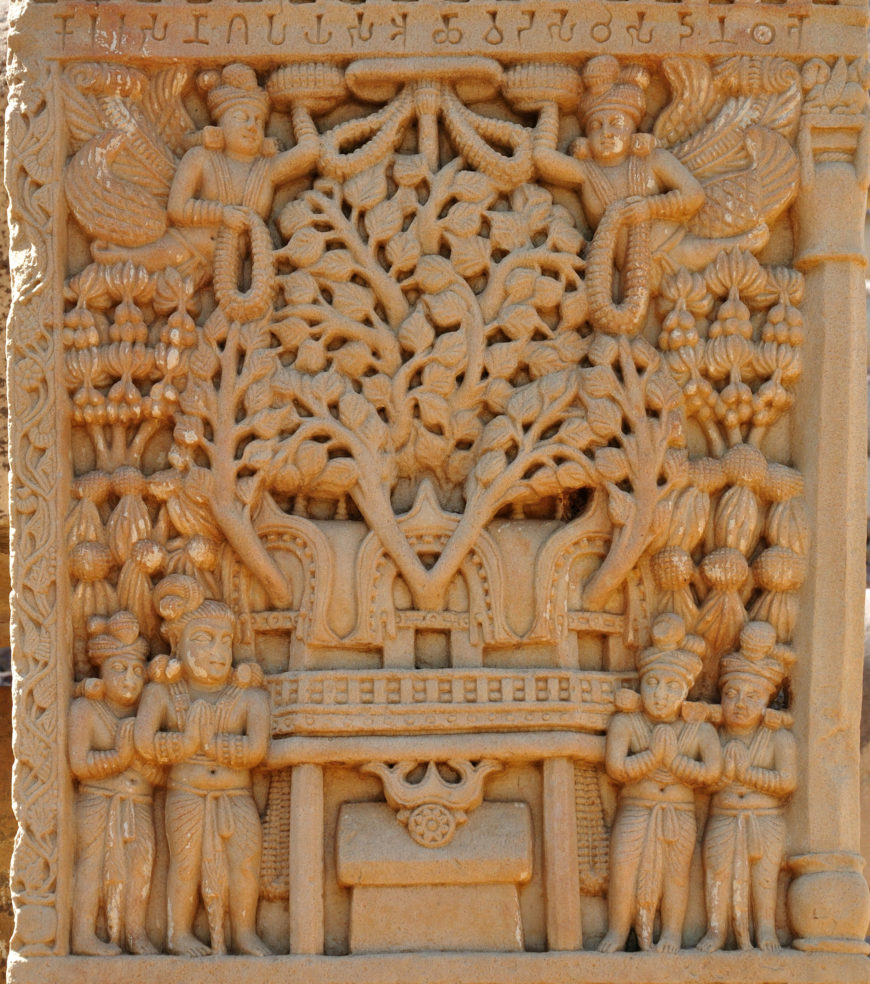
Bodhi tree with shrine, eastern gateway, Sanchi Stupa no. 1, 2nd–1st century B.C.E. (photo: Biswarup Ganguly , CC BY 3.0)
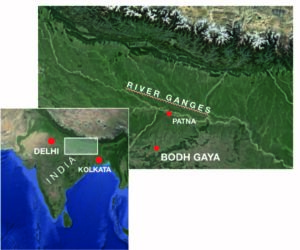
Map showing the location of Bodh Gaya
For centuries, religion, politics, myth, and history have converged around a small town on the banks of the Phalgu River just south of the state capital Patna in India. This extraordinary place—Bodh Gaya—is understood to be the site of the enlightenment, or “great awakening” (Sanskrit, mahabodhi ), of Siddhartha Gautama , the Buddha. It was here that Siddhartha Gautama sat in meditation under the Bodhi tree, having renounced his princely life to wander and practice asceticism. Here, he defeated temptation in the form of the demon Mara, and set a great world religion— Buddhism —into motion.
The events of the Buddha’s life are understood to have taken place sometime in the 5th century B.C.E. More than 2,500 years later, Bodh Gaya is a sprawling pilgrimage town dense with ancient, medieval, and modern shrines, monasteries, temples, and hotels. The historical and archaeological record at this sacred Buddhist center stretches back to at least the 3rd century B.C.E.
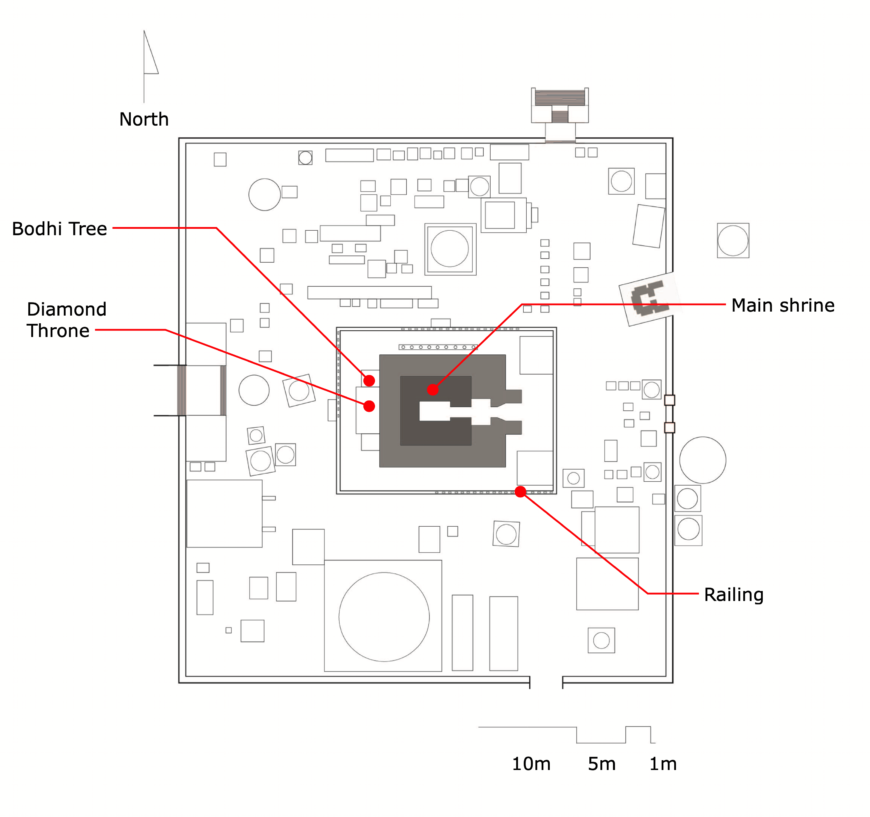
Plan of Mahabodhi Temple Complex, drawn from Cunningham, Mahabodhi , 1892, plate XVII (drawn by the author)
At the heart of ancient Bodh Gaya is the Mahabodhi Temple Complex, which is busy with shrines, monuments, and sculpted images established over more than 2,000 years. Three of the most important monuments will be discussed in this essay:
- The Bodhi tree
- The Vajrasana, or “Diamond Throne”
The Mahabodhi Temple
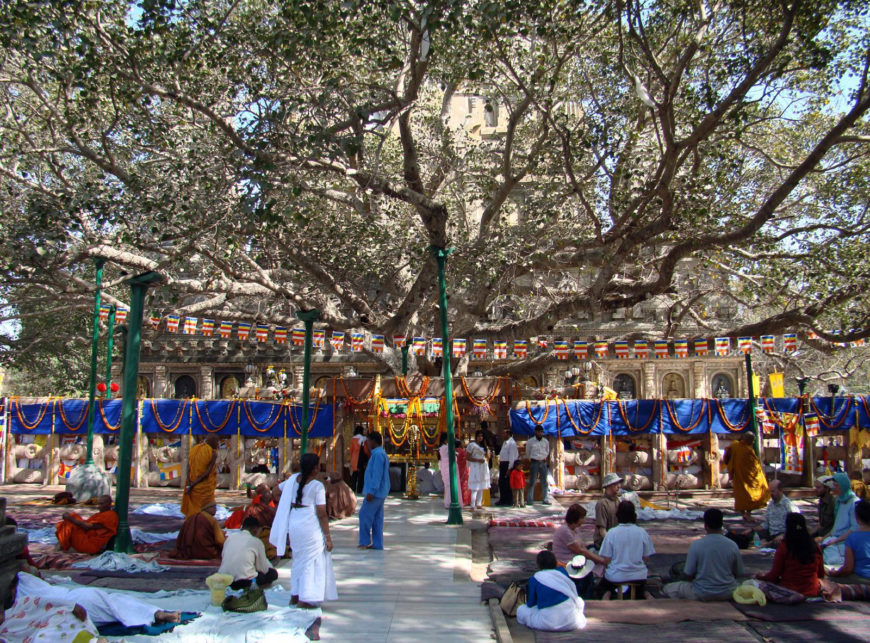
Buddhist convention in front of the Bodhi tree at Bodh Gaya, 2013 (photo: Triratna_Photos , CC BY-NC 2.0)
The Buddha’s Great Awakening
Siddhartha Gautama arrived at Bodh Gaya in middle age, having renounced his life as a prince on seeing the “four sights” of aging, sickness, death, and asceticism. It was the fourth sight that encouraged him to begin practicing extreme asceticism and meditation. Having done this for some time he became disillusioned with this extreme path and departed his ascetic companions wandering in north India until he arrived at the Bodhi tree (pipal tree or ficus religiosa ) on the banks of the Phalgu River. [1] Taking a seat under this tree to begin a long meditation, the Buddha-to-be was seen by the servant of a local noblewoman who, thinking he was a tree spirit, presented him with a bowl of rice and milk.
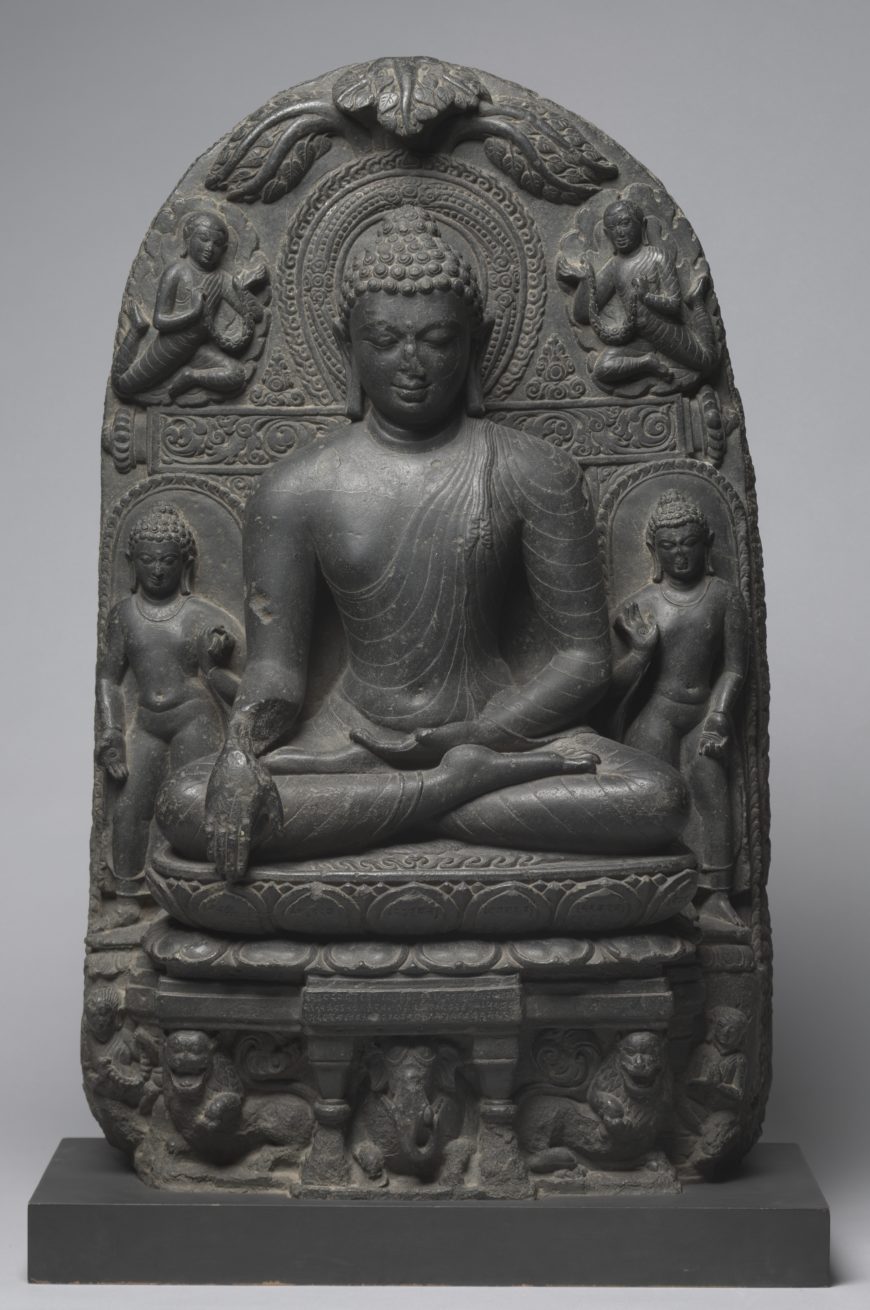
Buddha calling on the earth to witness , 9th century, Bihar, India ( Cleveland Museum of Art )
With this nourishment he continued to meditate under this tree and saw off the attacks of the demon Mara; who had sent both his demonic armies and daughters to distract the meditating Siddhartha Gautama. Finally, on that very night, the Buddha attained enlightenment. At that moment the Buddha was asked to provide a witness to this miraculous feat; and so the Buddha touched the earth with the fingers of his right hand, calling the Earth Goddess to witness. Buddhist traditions diverge on some of this account but this moment and the place at which it occurred, under the Bodhi tree at Bodh Gaya, is significant to all Buddhist traditions.
The Bodhi Tree today at Bodh Gaya
The Bodhi Tree
As the place where the Buddha attained enlightenment, Bodh Gaya appears to have become a significant place for Buddhists soon after the death of the Buddha and the formation of the Buddhist community of monks and nuns (Sanskrit, sangha ) and lay people. Very little is known, however, about the earliest structures at Bodh Gaya, and centuries of addition and alteration make it difficult to imagine how this site appeared at any particular moment in the past.

Timeline of key events at Bodh Gaya (drawn by the author)
From depictions of Bodh Gaya in art dating from the 2nd century B.C.E and early narrative accounts it can be surmised that devotion at this site initially focused on the Bodhi tree itself. It is likely that this tree was surrounded by a wooden enclosure-shrine (Sanskrit, bodhi-ghara ) by the 3rd century B.C.E., if not before.
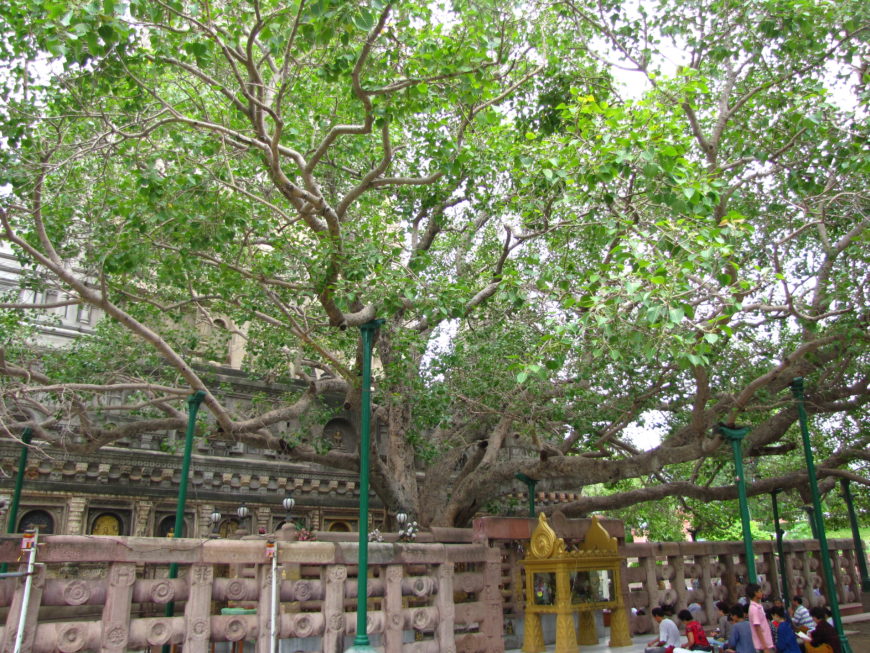
Bodhi tree inside stone railing (photo manbartlett , CC BY 2.0)
According to one early narrative, the enclosure around the Bodhi tree provided a platform from which the famous early Indian King Ashoka Maurya anointed the sacred Bodhi tree with milk. [2] The stone railings enclosing a descendent of this tree at Bodh Gaya today likely date to the 1st century B.C.E., and these reveal that this wooden shrine was later replaced by a stone structure .
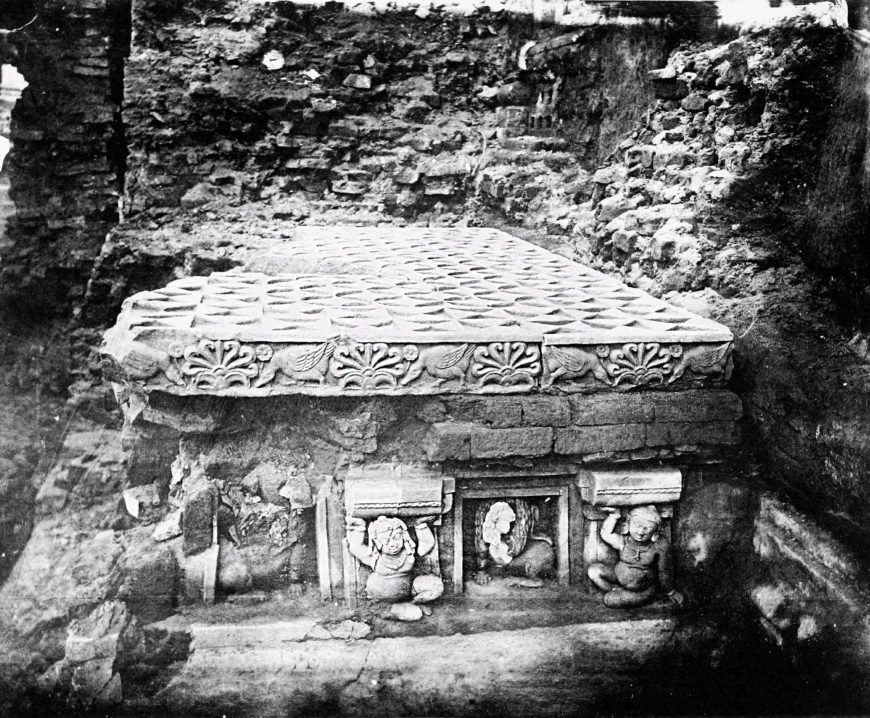
Diamond throne at excavation (Alexander Cunningham, Mahabodhi, 1892, Pl. XIII)
The Diamond Throne
A few centuries after the Buddha, a stone platform or throne was established under the Bodhi tree to mark the spot where the Buddha sat in meditation and acts as a second focus of devotion there. In some Buddhist traditions Bodh Gaya itself is referred to simply as the “Diamond Throne” (Sanskrit, vajrasana ), indicating the significance of this throne to the identity of this sacred site. Some of this throne remains in-situ, though it has been moved around the site at various times in the past.

Goose and palmette motif. Diamond throne at excavation (Alexander Cunningham, Mahabodhi, 1892, Pl. XIII)
The distinctive goose and palmette motif appearing in relief on the upper register of this polished sandstone slab allows art historians to date it to the time of the Mauryan dynasty (4th to 2nd century B.C.E.), and possibly even to the time of Ashoka Maurya.
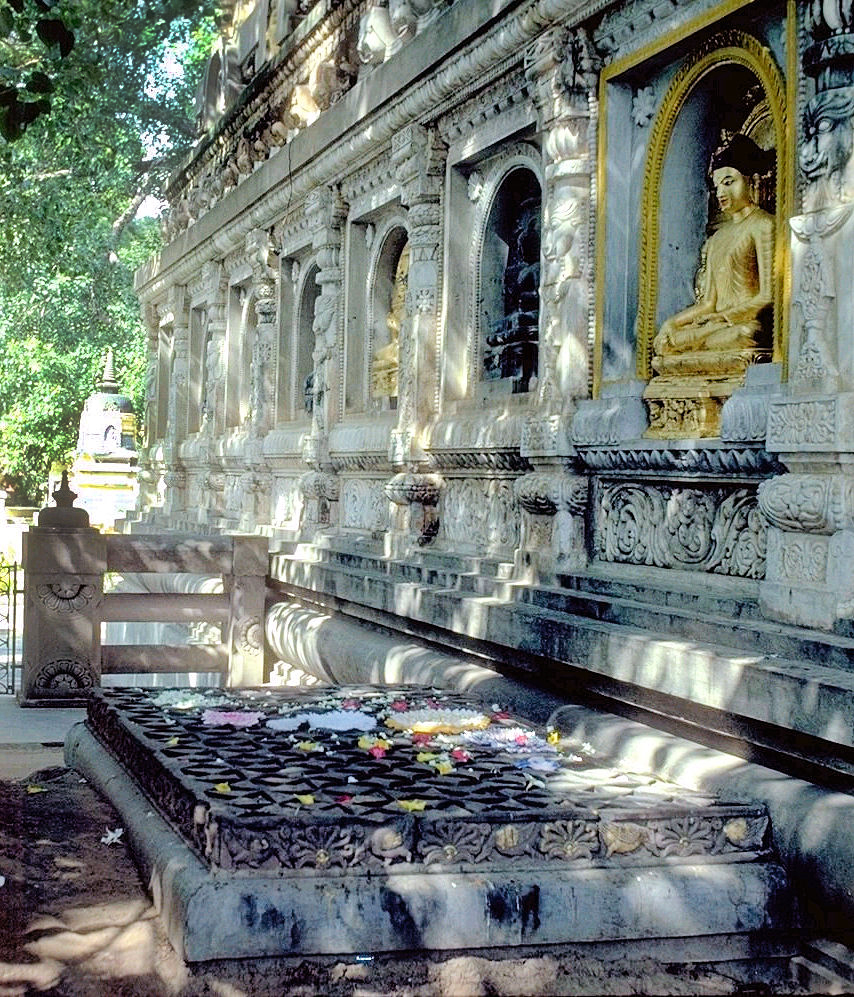
Diamond Throne of Ashoka at Bodh Gaya (photo: Christopher J. Fynn , CC BY-SA 3.0)
This throne has been moved around, restored, and altered many times in the past and is located today at the rear of the Mahabodhi Temple. The squat, atlas-like figures depicted in relief below the uppermost Mauryan throne likely date to the time of the Gupta dynasty (4th–6th century C.E.), if not a century or so earlier.
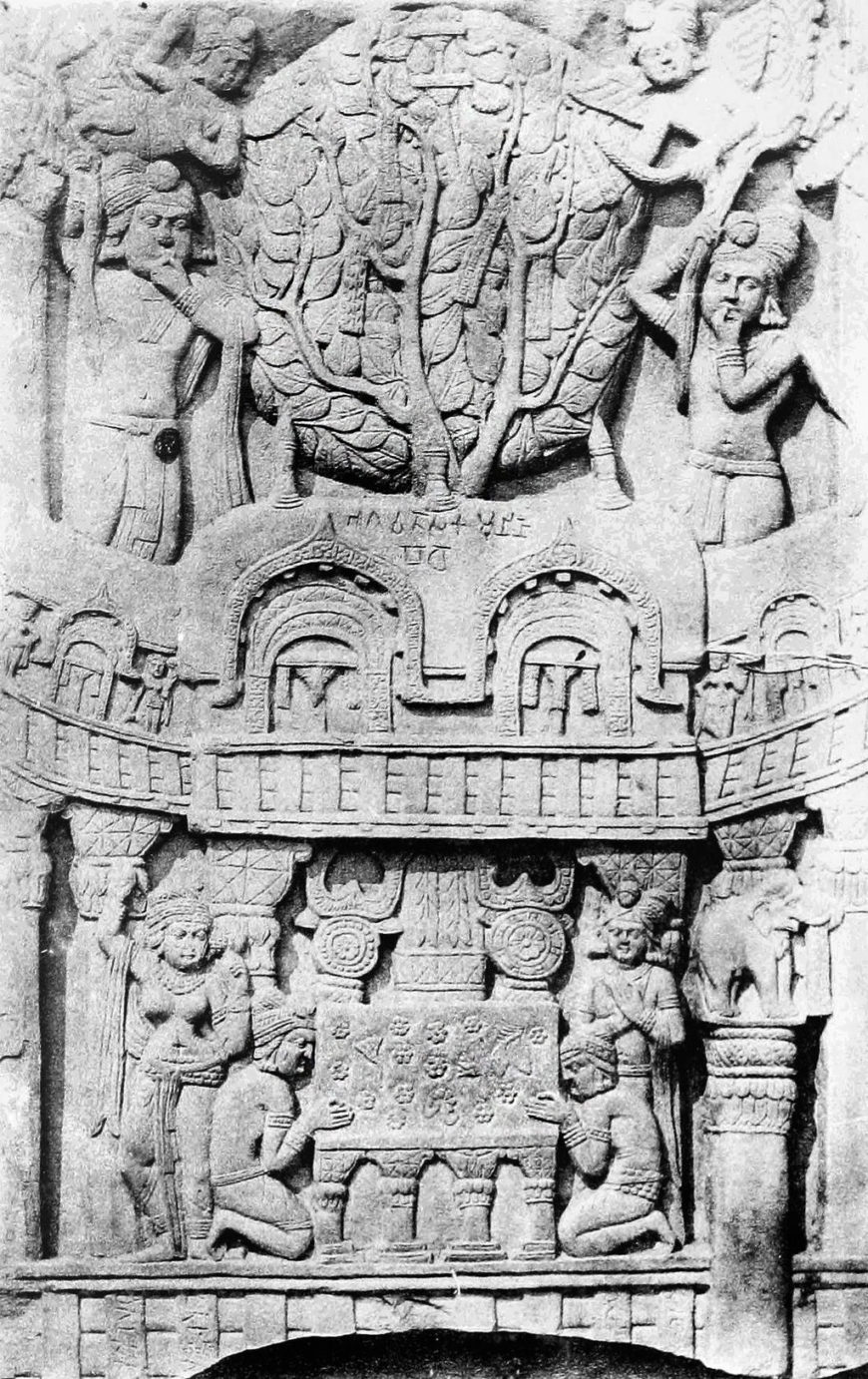
Bharhut relief with Diamond throne and Mahabodhi Temple around the Boddhi Tree (from Sir Alexander Cunningham, Mahâbodhi, or the great Buddhist temple under the Bodhi tree at Buddha-Gaya , 1892)
The combined image of this throne and the Bodhi tree was a popular image in early Buddhist art, which appears to have eschewed the depiction of the Buddha himself . The empty throne under the tree often acted as a sign for both the absent presence of the Buddha and for Bodh Gaya as a sacred site. The throne and the tree has remained an important sign for the Buddha and the moment of enlightenment throughout the history of Buddhist art, as can be seen in the early relief of the Bodhi tree with a shrine (at the top of this page) and in the common image of the Buddha calling on the earth to witness.
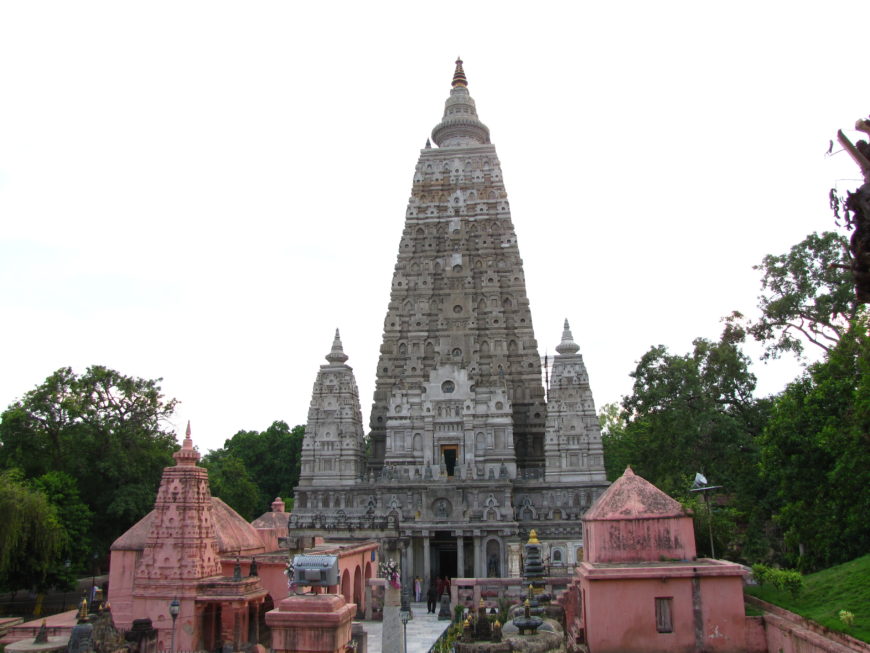
Mahabodhi Temple today, Bodh Gaya, Bihar, India (photo: manbartlett , CC BY 2.0)
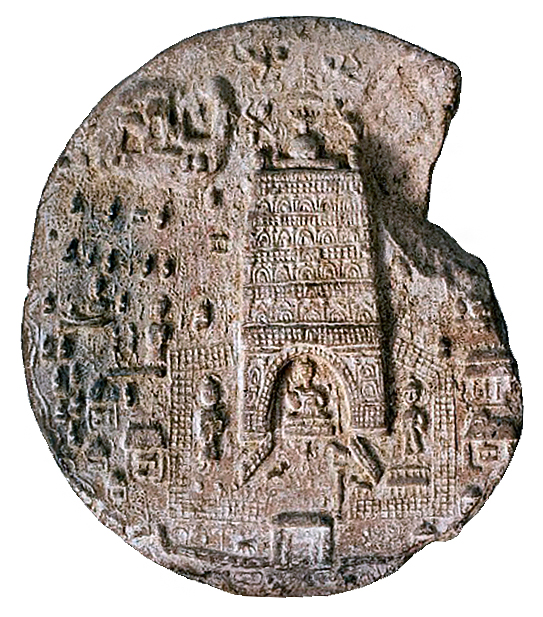
Mahābodhi plaque, 3rd century C.E. (Bihār Museum, Paṭnā Museum no. 4419).
The accounts of Chinese pilgrims who visited Bodh Gaya from at least the 5th century C.E. onwards give historians an idea of the next phase of construction at Bodh Gaya. Their accounts reveal that at some point in the early centuries of the Common Era the Bodhi tree and the Diamond Throne were partly superseded—or added to—by a towering temple housing a sculpted image of the Buddha.
Some art historians argue that a terracotta plaque from the 3rd century C.E. found near Patna represents the earliest Mahabodhi Temple. Whether or not this is the case, it is likely that the first iteration of the Mahabodhi Temple looked something like the one depicted: a tall straight-sided structure comprised of multiple layers of small arched “cow’s eye” windows ( gavaksha ) tapering slightly at the pinnacle and surmounted by parasols and banners marking the presence of the Buddha and surrounded by a railing on all sides. The temple depicted in this plaque also houses an image of the Buddha.
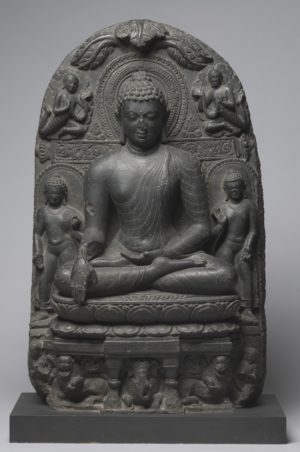
This broadly agrees with the description of Mahabodhi Temple given by the Chinese pilgrim Xuanzang who visited Bodh Gaya centuries later, at the end of the 7th century C.E. He describes a temple that is “160 or 170 feet high . . . [with] niches in the different storeys [holding] golden figures. The four sides of the building are covered with wonderful ornamental work.” [4]
According to Xuanzang and other pilgrims accounts, the Mahabodhi Temple housed a sculpted image of the Buddha in a seated position with his right hand touching the earth, recalling the moment of enlightenment when the Buddha “called the Earth to witness.” This image became an increasingly popular theme in Buddhist art around the 7th century C.E., as we see in the Buddha calling the earth to witness.
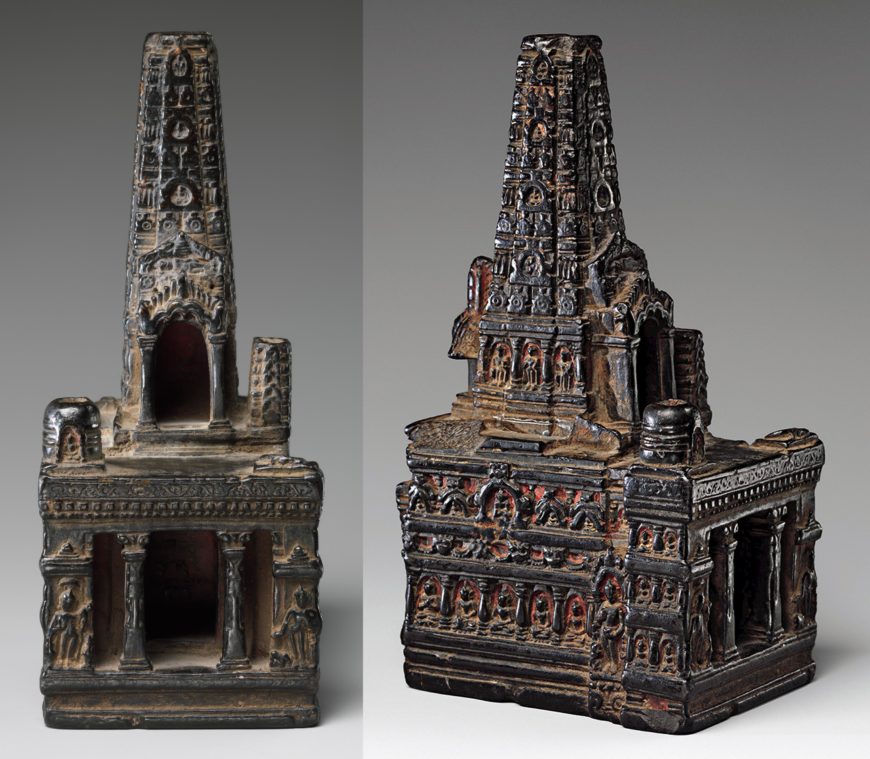
Model of the Mahabodhi Temple (front and side), 11th–12th century, Bihar, India ( The Metropolitan Museum of Art )
In subsequent centuries this “earth touching” Buddha image was combined with representations of the Mahabodhi Temple itself. These “pilgrim plaques” and miniature “models” of the Mahabodhi Temple give historians an idea of what this temple looked like at this time. Depictions of the Mahabodhi Temple also suggest the increasing importance of the temple housing the Buddha image in its own right as a sign for Bodh Gaya and the events there, although the Diamond Throne and the Bodhi tree continue to be depicted alongside them.
It is around this time too that inscriptions begin to refer to the Mahabodhi Temple as the “ vajrasana-gandhakuti ,” literally the “perfume chamber (i.e. temple) with the Diamond Throne.” These inscriptions, the depictions of the Mahabodhi Temple in art, and other evidence for royal and foreign-sponsored programs of restoration suggest an important shift from tree shrine to the building of temples, shrines, and monasteries at Bodh Gaya over the course of the 1st millennium C.E. [3]
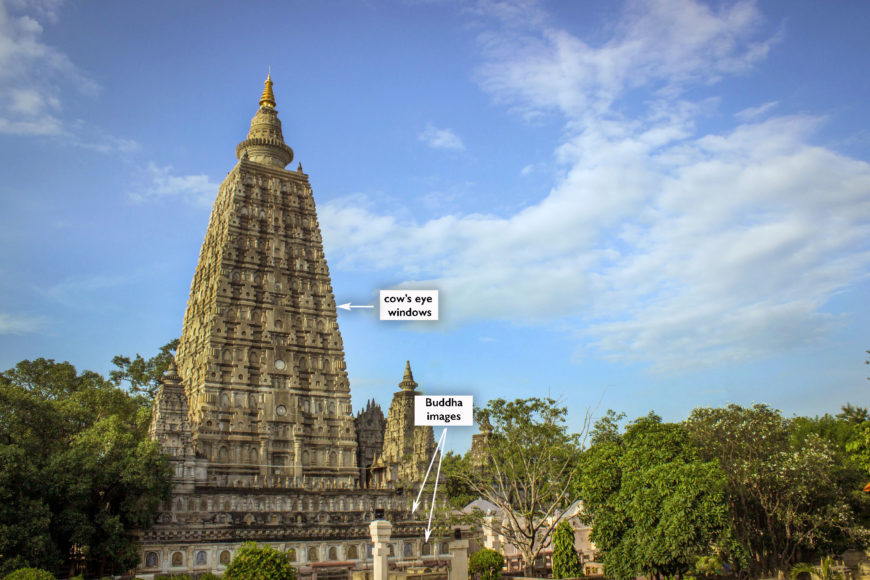
Mahabodhi Temple, Bodh Gaya, Bihar, India (photo: Santosh Kumar , CC BY-SA 2.0)
The Mahabodhi Temple today
The Mahabodhi Temple as it appears today is mostly the product of restorations undertaken in the late 19th century: first by a Burmese mission and then overseen by the recently established Archaeological Survey of India (see the timeline above). The towering brick, stucco and concrete temple seen at Bodh Gaya today comprises a large primary straight-sided spire (Sanskrit, shikhara ), rising out of a central image chamber (Sanskrit, garbha-griha ). Four smaller spires sit on the corner of the main chamber and each of these is, like the primary spire, surmounted by the form of a Buddhist relic mound (Sanskrit, stupa ) . The surface of the temple is studded with receding levels of Buddha images set into niches alternating with circular “cow’s eye windows,” not unlike the accounts of Chinese pilgrims and early depictions of this building in art.
The late 19th-century restoration of the Mahabodhi Temple Complex at Bodh Gaya made significant alterations to the site, however. Although these were based on architectural remains and models such as that shown in the model of the temple, pre-restoration paintings and photographs reveal how much was invented, such as the gateway pavilion on the second storey, the four corner spires, and much of the surface ornament. This period of restoration and partial excavation of the complex also brought to light the many small “votive” (pertaining to a wish) shrines and images which had steadily built up around the temple over centuries.
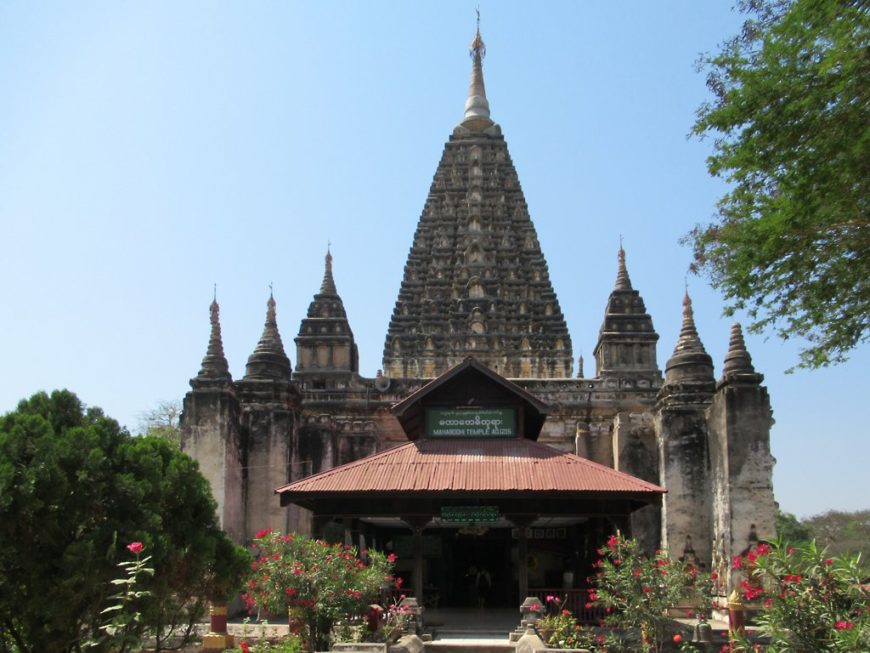
Mahabodhi Phaya, Pagan, Myanmar (photo: David-Stanley , CC BY 2.0)
Many Mahabodhis: replication of Bodh Gaya
An important feature of Bodh Gaya and the Mahabodhi Temple Complex is its replication across Asia. What might be called “replica” Mahabodhi temples were built across Asia from the 13th century onwards: the Mahabodhi Phaya in Myanmar, Wat Chet Yot in Thailand, Wuta Si in China, and the Mahabuddha Temple in Nepal are important examples.
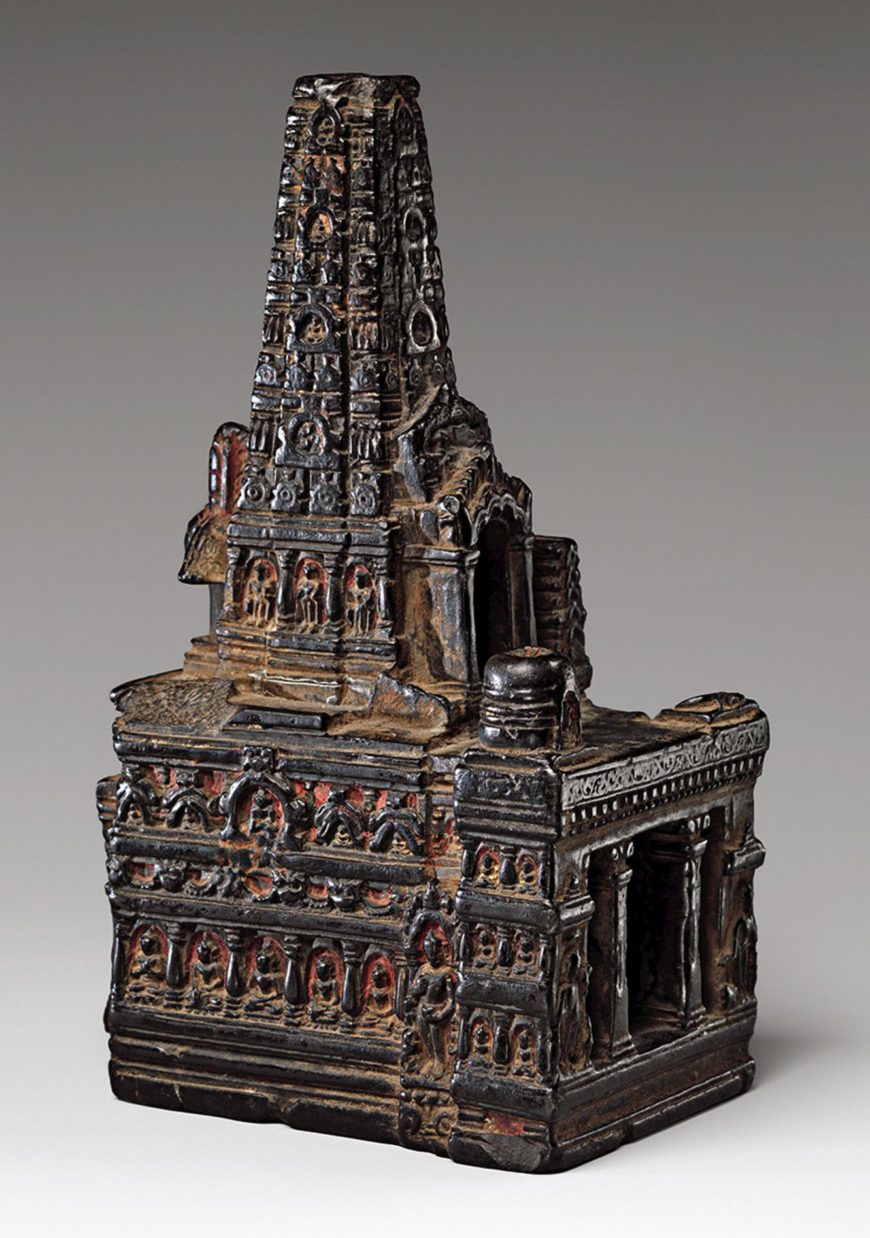
Model of the Mahabodhi Temple, 11th–12th century, Bihar, India ( The Metropolitan Museum of Art )
Each of these structures imitate the form of the Mahabodhi Temple at Bodh Gaya, though they vary in style, building technology, and materials. Each temple works with similar assumptions of the Mahabodhi Temple form, being mostly organized around four towers surrounding a central larger tower. It is likely that some of these replicas were built from the recollections of pilgrims, if not on even small portable artworks and “models” carried away from Bodh Gaya such as that shown in model of the temple at The Metropolitan Museum of Art. These other Mahabodhi Temples may have been constructed because access to north Indian Buddhist sites was not easy for Buddhist pilgrims, especially at a time when monastic Buddhism had declined in the region. How and why these many Mahabodhi Temple were built, however, remains unclear; likely each of these buildings was built for a specific purpose in each context but all of them can be understood to, in a sense, transfer the Buddhist “holy land” abroad.
This replication of Bodh Gaya in the medieval and early modern period in Asia finds an earlier precedent in the account given in the Sri Lankan chronicle ( mahavamsa ) which records how a branch of the Bodhi tree was brought to Sri Lanka and planted in the city of Anuradhapura in the time of King Ashoka, where its descendant grows to this day. [5]
Bodh Gaya Today
International interest in Bodh Gaya increased from the 1880s onwards, particularly after the Archaeological Survey of India restored and landscaped much of the Mahabodhi Temple Complex. This ushered in a new phase of patronage, construction, and contention at the site. Over the course of the 20th century, international Buddhist communities and associations began to establish temples, monasteries, and guest houses in the town. Today at least forty different Buddhist organizations are represented in Bodh Gaya—a town with a mostly Hindu and Muslim population.
Many of the sculptures found at Bodh Gaya—including those used in worship today—date to the time of the Pala dynasty (8th–12th century C.E.) and depict both Buddhist and non-Buddhist deities. And it is likely that Bodh Gaya held significance within a network of sacred and pilgrimage sites in the region, both for Buddhists and other religious communities. It is also important to note that Bodh Gaya neighbors the major Hindu pilgrimage town of Gaya: an ancient sacred center associated with ancestor rites (Sanskrit, shraddha ).
Indeed a major Shaiva (pertaining to the Hindu god Shiva) monastery was established just north of the Mahabodhi Temple Complex in the 18th century C.E., and this community of renunciates (people who renounces earthly pleasures and lives as ascetics) assumed administrative control of the complex around this time. Until recently the Shaiva Mahant (head of monastery) took up residence in a small building just opposite the Mahabodhi Temple and worshipped images of Buddhist deities installed there as forms of Hindu gods.
Relationships at Bodh Gaya became strained in the late 19th and early 20th century, and the ownership and authority of the Mahabodhi Temple in particular became contested. It was initially in order to “reclaim Bodh Gaya for Buddhists” that the Sri Lankan-born Buddhist revivalist Anagarika Dharmapala established the Maha Bodhi Society in Colombo, Sri Lanka, in 1891. The Maha Bodhi Society campaigned to overturn Shaiva Hindu authority at the Mahabodhi Complex by appealing to first British colonial authorities and then to the independent Republic of India after 1947. After a lengthy legal battle, the question of ownership of the Mahabodhi Temple Complex was partially resolved in 1949 after the Indian Government assumed control of the site for the State of Bihar and established the Bodh Gaya Temple Management Committee (BTMC), which was composed of both Hindu and Buddhist members.
With the Mahabodhi Temple Complex at Bodh Gaya added to the UNESCO World Heritage List in 2002, responsibility for this place shifted once again. While its new status as “World Heritage” brought international attention and renown to Bodh Gaya, it has also caused some concern that the spiritual and devotional character of Bodh Gaya will be altered and even that Bodh Gaya will be “museumized”—its built remains being preserved at the expense of the range of sacred, devotional, and architectural practices that have characterized the place for more than 2,000 years.
The Timeless Seat of the Buddha
Bodh Gaya has a long and complex history. Over millennia it has been reconstructed and reimagined; it is steeped in significance and stories. The variety of perceptions of this place across the Buddhist world and more locally are reflected in the site’s physical history: the densely packed amalgam of structures, shrines, and sculptures that span the breadth of two millennia. Each addition, whether physical or conceptual, has built upon an earlier layer, changing Bodh Gaya without entirely erasing that which came before. The Bodhi tree, the railing, and the Diamond Throne remain at Bodh Gaya alongside the towering temple, the Buddha image, the Shaiva Mahant’s residence and — a hotel and a museum.
[1] For the life of the Buddha see, Patrick Olivelle, Life of the Buddha, Clay Sanskrit Library; 33 (New York University Press, 2008); and The Play in Full, translated by the Dharmachakra Translation Committee under the patronage and supervision of 84000: Translating the Words of the Buddha, 2013.
[2] See John S. Strong, The Legend of King Asoka. (Princeton: Princeton University Press, 1984), pp. 250-266.
[3] See Geri H. Malandra “The Mahabodhi Temple” in Janice Leoshko, Bodhgaya, the Site of Enlightenment. (Bombay: Marg Publications, 1988), pp. 9–28.
[4] See Samuel Beal trans. Si-yu-ki: Buddhist Records of the Western World (London, 1884; reprinted Delhi, 1981), 118–119.
[5] See Vidya Dehejia, “Bodh Gaya and Sri Lanka” in Janice Leoshko, Bodhgaya, the Site of Enlightenment. (Bombay: Marg Publications, 1988), pp. 89–100.
Additional resources
Archaeological Survey of India
Archaeological Survey of India on Google Arts and Culture
David Geary, Matthew R. Sayers and Abhishek Singh Amar, Cross-disciplinary Perspectives on a Contested Buddhist Site (Routledge, 2012).
Janice Leoshko, Bodhgaya, the Site of Enlightenment (Marg Publications, 1988).
Prudence R. Myer, “The Great Temple at Bodh-Gaya,” The Art Bulletin vol. 40 (1958).
Cite this page
Your donations help make art history free and accessible to everyone!
We've begun to update our look on video and essay pages!

Smarthistory's video and essay pages look a little different but still work the same way. We're in the process of updating our look in small ways to make Smarthistory's content easy to read and accessible on all devices. You can now also collapse the sidebar for focused watching and reading, then open it back up to navigate. We'll be making more improvements to the site over the next few months!
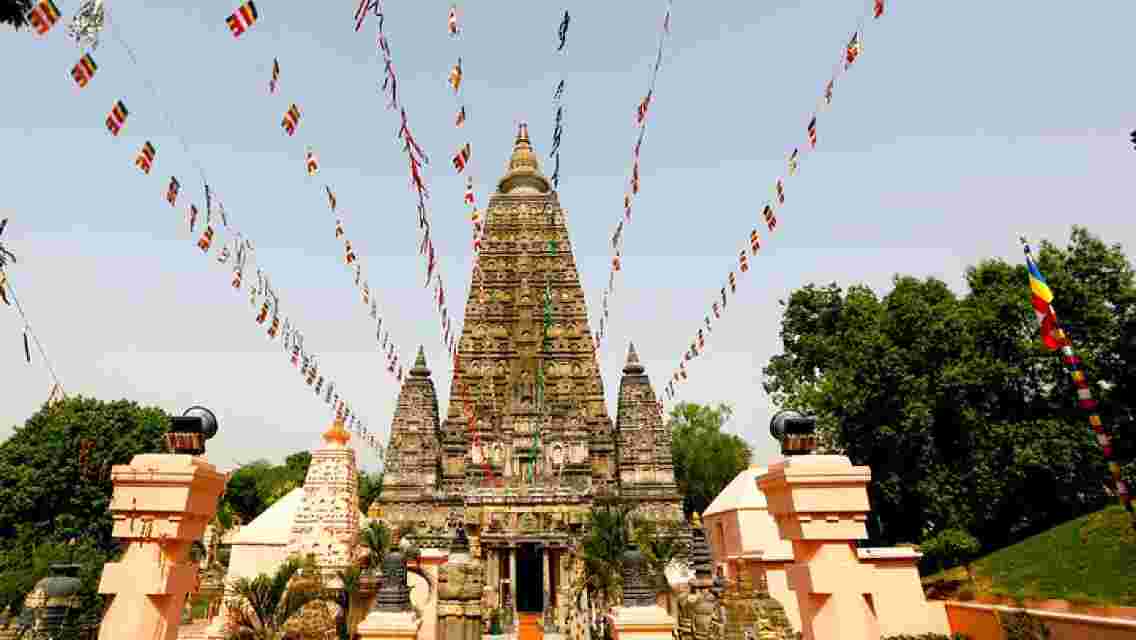
Discovering Serenity: The Sacred Mahabodhi Temple Complex at Bodh Gaya, Bihar
- Post author By Mala Chandrashekhar
- Post date February 12, 2024
- No Comments on Discovering Serenity: The Sacred Mahabodhi Temple Complex at Bodh Gaya, Bihar
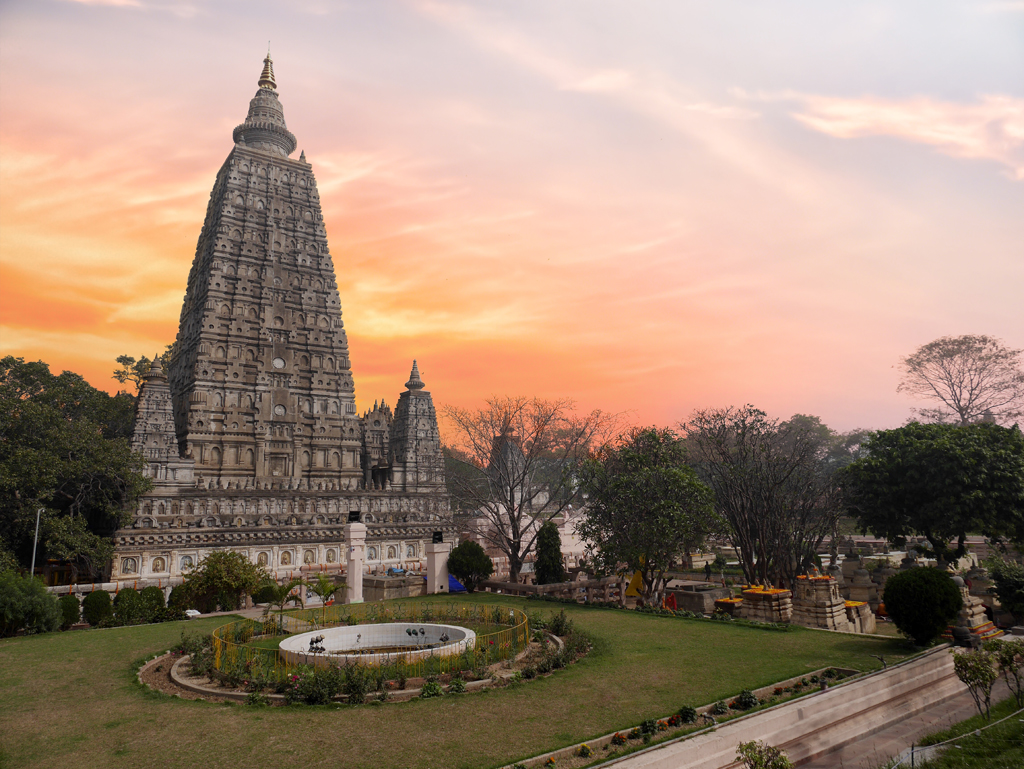
Introduction:
Nestled in the serene town of Bodh Gaya, Bihar, the Mahabodhi Temple Complex stands as an iconic symbol of enlightenment and spiritual significance. This sacred site is believed to be the place where Gautama Buddha attained enlightenment, making it one of the most revered pilgrimage destinations for Buddhists worldwide. Steeped in history, spirituality, and architectural grandeur, the Mahabodhi Temple Complex offers a captivating journey into the heart of Buddhism. Join us as we embark on a virtual tour and unravel the timeless allure of this remarkable site.

Historical Significance:
The history of the Mahabodhi Temple Complex dates back to the 3rd century BCE when Emperor Ashoka, a devout Buddhist, erected a shrine on the spot where the Buddha achieved enlightenment. Over the centuries, the temple complex has undergone numerous renovations and restorations, evolving into its present form. In 2002, it was designated as a UNESCO World Heritage Site, further cementing its historical and cultural importance.
Architectural Marvels:
The Mahabodhi Temple, the centerpiece of the complex, is a magnificent architectural marvel that showcases a blend of various architectural styles spanning several centuries. Its main tower, soaring to a height of 55 meters, is adorned with intricate carvings and depicts stories from the life of Buddha. The temple complex also houses several other temples and monasteries built by devotees from different Buddhist traditions, including the Thai Monastery, Japanese Temple, and Tibetan Monastery, each reflecting their unique architectural styles.
The Bodhi Tree:
The sacred Bodhi Tree, located within the temple complex, is an object of veneration and utmost reverence for Buddhists. It is believed to be a direct descendant of the original Bodhi Tree under which the Buddha attained enlightenment. Devotees from all over the world gather around the tree to meditate, offer prayers, and seek spiritual solace. The peaceful ambiance and the gentle rustling of leaves create an aura of tranquility, inviting visitors to introspect and connect with their inner selves.

Spiritual Significance:
Visiting the Mahabodhi Temple Complex is an ethereal experience that transcends religious boundaries. The complex serves as a pilgrimage site for Buddhists from various traditions, as well as a place of curiosity and fascination for people interested in exploring Buddhism. The atmosphere is filled with a sense of spiritual energy, and the devotion and faith of the pilgrims are palpable, creating a transformative atmosphere for all who visit.
Exploring Bodh Gaya:
Beyond the Mahabodhi Temple Complex, Bodh Gaya offers a plethora of cultural and historical attractions. The Archaeological Museum adjacent to the temple houses a rich collection of artifacts, statues, and relics related to Buddhism. The Dungeshwari Cave Temples, where Buddha spent six years in austerity before attaining enlightenment, are located a short distance away and provide a tranquil retreat for contemplation. Additionally, Bodh Gaya boasts vibrant local markets, where visitors can find handicrafts, Buddhist art, and various spiritual souvenirs.

Conclusion:
A journey to the Mahabodhi Temple Complex at Bodh Gaya is a pilgrimage for the soul, an opportunity to delve into the rich tapestry of Buddhist history and spirituality. The aura of enlightenment that permeates the site is contagious, leaving visitors with a sense of peace, introspection, and reverence. Whether you are a devout Buddhist seeking spiritual awakening or a curious traveler interested in immersing yourself in a unique cultural experience, Bodh Gaya will undoubtedly leave an indelible mark on your heart and mind.
By Mala Chandrashekhar
Introducing Blogger Mala Chandrashekhar - a specialist academically trained in modern Western sciences, yet deeply enamored with India's timeless ethnic arts, crafts, and textiles. Her heart beats for the rich and glorious cultural and spiritual heritage of India, and she has dedicated her entire blog to spreading the immortal glories of ancient India worldwide. Through her simple yet impactful blog posts, Mala aims to reach every nook and corner of the globe, sharing India's beauty and wisdom with the world.
But Mala doesn't stop at just sharing her own thoughts and ideas. She welcomes constructive criticisms and suggestions to improve her blog and make it even more impactful. And if you share her passion for India's culture and heritage, she extends a warm invitation for high-quality guest blog posts.
Ready to dive into the world of India's ageless beauty? Follow Mala on LinkedIn and join her in spreading the magic of ancient India to the world.
LinkedIn Profile : https://in.linkedin.com/in/mala-chandrashekhar-04095917a
Leave a Reply Cancel reply
Your email address will not be published. Required fields are marked *
Save my name, email, and website in this browser for the next time I comment.
THE 10 BEST Bodh Gaya Tours & Excursions
Bodh gaya tours.
- Private Tours
- Sightseeing Tours
- Cultural Tours
- Historical & Heritage Tours
- Archaeology Tours
- Multi-day Tours
- Walking Tours
- Ports of Call Tours
- Up to 1 hour
- 1 to 4 hours
- 4 hours to 1 day
- 5.0 of 5 bubbles
- 4.0 of 5 bubbles & up
- 3.0 of 5 bubbles & up
- 2.0 of 5 bubbles & up
- Chinese (Simplified)
- The ranking of tours, activities, and experiences available on Tripadvisor is determined by several factors including the revenue generated by Tripadvisor from these bookings, the frequency of user clicks, and the volume and quality of customer reviews. Occasionally, newly listed offerings may be prioritized and appear higher in the list. The specific placement of these new listings may vary.

1. Bodhgaya Day Tour (Hotel Pickup)

2. Same day Bodhgaya tour from Varanasi

3. Full-Day Private Guided Bodhgaya Tour with Pick Up

4. Full Day Tour in Bodhgaya Hotel pick up

5. Nalanda Rajgir and Bodh Gaya from Patna

6. Guided Virtual Tour of Bodhgaya

7. 7 Days Varanasi to Lumbini Buddhist Expedition ( All Inclusive )

8. Buddhist Tour 7 Day

9. Full-Day Bodh Gaya Private Tour from Patna

10. Buddhist Tour From The Birth To Death

11. Pinddaan In Gaya

12. Private guided tour of Bodh Gaya over 2 days

13. Exclusive Guided Tour of Bodh Gaya

14. Varanasi - Allahabad - Gaya Tour - 4n5d

15. 2 Days Enlightening Bodhgaya Tour from Varanasi

16. Spiritual Tour of Bodhgaya & Varanasi (5 Days)

17. Pinddaan at Gaya

18. Full Day Private Trip to Bodhgaya from Varanasi

19. Bodhgaya Tour from Varanasi 2 Days 1 Night

20. Bodhgaya and Gaya Pilgrimage Tour

21. 10 Days Private Buddhist Circuit Tour in Varanasi

22. Buddhist Pilgrimage Tour

23. Two Days Cultural Tour of Bodhgaya from Varanasi


24. Affordable Bodh Gaya Airport Transfer

25. 3 Days Budget tour to Bodhgaya, Rajgir and Nalanda

26. Day Trip To Nalanda And Rajgir From Bodhgaya With Lunch

27. 3 Days Enlightening tour to Bodhgaya, Rajgir and Nalanda

28. Explore Bodhgaya - Lord Buddha's Enlightenment Place

29. The Ancient Wonders of Nalanda & Rajgir Day Trip From Bodhgaya

30. Enlightenment Trail: Exploring Bodh Gaya And Gaya
What travelers are saying.
- Bodhgaya Day Tour (Hotel Pickup)
- Same day Bodhgaya tour from Varanasi
- 2 Days Bodhgaya Tour from Varanasi
- Full-Day Private Guided Bodhgaya Tour with Pick Up
- Full-Day Bodh Gaya Private Tour from Patna
- Bihar Trips (KTEC Tours)
- BODHGAYA TAXI SERVICE
- Abram Travels
- Travel Bureau - Bodh Gaya
- Shanti Tourism Bodhgaya
- Punpun Trails
Top Tours in Bodh Gaya, India
Bodh gaya tours.
- Private Tours
- Sightseeing Tours
- Cultural Tours
- Historical & Heritage Tours
- Archaeology Tours
- Multi-day Tours
- Walking Tours
- Ports of Call Tours
- Up to 1 hour
- 1 to 4 hours
- 4 hours to 1 day
- 5.0 of 5 bubbles
- 4.0 of 5 bubbles & up
- 3.0 of 5 bubbles & up
- 2.0 of 5 bubbles & up
- Chinese (Simplified)
- The ranking of tours, activities, and experiences available on Tripadvisor is determined by several factors including the revenue generated by Tripadvisor from these bookings, the frequency of user clicks, and the volume and quality of customer reviews. Occasionally, newly listed offerings may be prioritized and appear higher in the list. The specific placement of these new listings may vary.

1. Bodhgaya Day Tour (Hotel Pickup)

2. Same day Bodhgaya tour from Varanasi

3. Full-Day Private Guided Bodhgaya Tour with Pick Up

4. Full Day Tour in Bodhgaya Hotel pick up

5. Nalanda Rajgir and Bodh Gaya from Patna

6. Guided Virtual Tour of Bodhgaya

7. 7 Days Varanasi to Lumbini Buddhist Expedition ( All Inclusive )

8. Buddhist Tour 7 Day

9. Full-Day Bodh Gaya Private Tour from Patna

10. Buddhist Tour From The Birth To Death

11. Pinddaan In Gaya

12. Private guided tour of Bodh Gaya over 2 days

13. Exclusive Guided Tour of Bodh Gaya

14. Varanasi - Allahabad - Gaya Tour - 4n5d

15. 2 Days Enlightening Bodhgaya Tour from Varanasi

16. Spiritual Tour of Bodhgaya & Varanasi (5 Days)

17. Pinddaan at Gaya

18. Full Day Private Trip to Bodhgaya from Varanasi

19. Bodhgaya Tour from Varanasi 2 Days 1 Night

20. Bodhgaya and Gaya Pilgrimage Tour

21. 10 Days Private Buddhist Circuit Tour in Varanasi

22. Buddhist Pilgrimage Tour

23. Two Days Cultural Tour of Bodhgaya from Varanasi

24. Affordable Bodh Gaya Airport Transfer

25. 3 Days Budget tour to Bodhgaya, Rajgir and Nalanda

26. Day Trip To Nalanda And Rajgir From Bodhgaya With Lunch

27. 3 Days Enlightening tour to Bodhgaya, Rajgir and Nalanda

28. Explore Bodhgaya - Lord Buddha's Enlightenment Place

29. The Ancient Wonders of Nalanda & Rajgir Day Trip From Bodhgaya

30. Enlightenment Trail: Exploring Bodh Gaya And Gaya
What travellers are saying.
- Bodhgaya Day Tour (Hotel Pickup)
- Same day Bodhgaya tour from Varanasi
- 2 Days Bodhgaya Tour from Varanasi
- Full-Day Private Guided Bodhgaya Tour with Pick Up
- Full-Day Bodh Gaya Private Tour from Patna
- Bihar Trips (KTEC Tours)
- BODHGAYA TAXI SERVICE
- Abram Travels
- Travel Bureau - Bodh Gaya
- Shanti Tourism Bodhgaya
- Punpun Trails

Skip to main content
- Select your language English हिंदी
Social Share
The mahabodhi temple complex, bodh gaya.
- From UNESCO
The Mahabodhi Temple Complex is one of the four holy sites related to the life of the Lord Buddha, and particularly to the attainment of Enlightenment. The first temple was built by Emperor Asoka in the 3rd century B.C., and the present temple dates from the 5th or 6th centuries. It is one of the earliest Buddhist temples built entirely in brick, still standing in India, from the late Gupta period.
Outstanding Universal Value
Brief synthesis
The Mahabodhi Temple Complex, Bodh Gaya lies 115 km south of the state capital of Bihar, Patna and 16 km from the district headquarters at Gaya, in Eastern India. It is one of the four holy sites related to the life of the Lord Buddha, and particularly to the attainment of Enlightenment. The property encompasses the greatest remains of the 5th-6th century A.D in the Indian sub-continent belonging to this period of antiquity. The property has a total area of 4.8600 ha.
The Mahabodhi Temple Complex is the first temple built by Emperor Asoka in the 3rd century B.C., and the present temple dates from the 5th–6th centuries. It is one of the earliest Buddhist temples built entirely in brick, still standing, from the late Gupta period and it is considered to have had significant influence in the development of brick architecture over the centuries.
The present Mahabodhi Temple Complex at Bodh Gaya comprises the 50 m high grand Temple, the Vajrasana, sacred Bodhi Tree and other six sacred sites of Buddha's enlightenment, surrounded by numerous ancient Votive stupas, well maintained and protected by inner, middle and outer circular boundaries. A seventh sacred place, the Lotus Pond, is located outside the enclosure to the south. Both the temple area and the Lotus Pond are surrounded by circulating passages at two or three levels and the area of the ensemble is 5 m below the level of the surrounding land.
It is also a unique property of archaeological significance in respect of the events associated with the time Lord Buddha spent there, as well as documenting the evolving worship, particularly since the 3rd century, when Emperor Asoka built the first temple, the balustrades and the memorial column and the subsequent evolution of the ancient city with the building of sanctuaries and monasteries by foreign kings over the centuries.
The Main Temple wall has an average height of 11 m and it is built in the classical style of Indian temple architecture. It has entrances from the east and from the north and has a low basement with mouldings decorated with honeysuckle and geese design. Above this is a series of niches containing images of the Buddha. Further above there are mouldings and chaitya niches, and then the curvilinear shikhara or tower of the temple surmounted by amalaka and kalasha (architectural features in the tradition of Indian temples). At the four corners of the parapet of the temple are four statues of the Buddha in small shrine chambers. A small tower is built above each of these shrines. The temple faces east and consists of a small forecourt in the east with niches on either side containing statues of the Buddha. A doorway leads into a small hall, beyond which lies the sanctum, which contains a gilded statue of the seated Buddha (over 5ft high) holding earth as witness to his achieved Enlightenment. Above the sanctum is the main hall with a shrine containing a statue of Buddha, where senior monks gather to meditate.
From the east, a flight of steps leads down through a long central path to the main temple and the surrounding area. Along this path there are significant places associated with events that immediately followed the Buddha’s Enlightment, together with votive stupas and shrines.
The most important of the sacred places is the giant Bodhi Tree, to the west of the main temple, a supposed direct descendant of the original Bodhi Tree under which Buddha spent his First Week and had his enlightment. To the north of the central path, on a raised area, is the Animeshlochan Chaitya (prayer hall) where Buddha is believed to have spent the Second Week. Buddha spent the Third Week walking eighteen paces back and forth in an area called Ratnachakrama (the Jewelled Ambulatory), which lies near the north wall of the main temple. Raised stone lotuses carved on a platform mark his steps. The spot where he spent the Fourth Week is Ratnaghar Chaitya, located to the north-east near the enclosure wall. Immediately after the steps of the east entrance on the central path there is a pillar which marks the site of the Ajapala Nigrodh Tree, under which Buddha meditated during his Fifth Week, answering the queries of Brahmans. He spent the Sixth Week next to the Lotus Pond to the south of the enclosure, and the Seventh Week was spent under the Rajyatana Tree, to the south-east of the main temple, currently marked by a tree.
Next to the Bodhi Tree there is a platform attached to the main temple made of polished sandstone known as Vajrasana (the Diamond Throne), originally installed by Emperor Asoka to mark the spot where Buddha sat and meditated. A sandstone balustrade once encircled this site under the Bodhi Tree, but only a few of the original pillars of the balustrade are still in situ; they contain carvings of sculpted human faces, animals, and decorative details. Further up the central path towards the main temple to the south is a small shrine with a standing Buddha in the back and with the footprints (Padas) of the Buddha carved on black stone, dating from the 3rd century BC when Emperor Asoka declared Buddhism to be the official religion of the state and installed thousands of such footprint stones all over his kingdom. The gateway to the Temple, which is on the central path, was also originally built by this Emperor, but was later rebuilt. Further on the path towards the main temple is a building housing several statues of Buddha and Bodhisattvas. Opposite is a memorial to a Hindu Mahant who had lived on this site during the 15th and 16th centuries. To the south of the pathway is a cluster of votive stupas built by kings, princes, noblemen and lay people. They vary in shape and size, from the simplest to the most sumptuous ones.
In the context of philosophical and cultural history, Mahabodhi Temple Complex is of great relevance as it marks the most important event in the life of Lord Buddha, the moment when Prince Siddhartha attained Enlightenment and became Buddha, an event that shaped human thought and belief. This property is now revered as the holiest place of Buddhist pilgrimage in the world and is considered the cradle of Buddhism in the history of mankind.
Criterion (i): The grand 50m high Mahabodhi Temple of the 5th-6th centuries is of immense importance, being one of the earliest temple constructions existing in the Indian sub-continent. It is one of the few representations of the architectural genius of the Indian people in constructing fully developed brick temples in that era
Criterion (ii): The Mahabodhi Temple, one of the few surviving examples of early brick structures in India, has had significant influence in the development of architecture over the centuries.
Criterion (iii): The site of the Mahabodhi Temple provides exceptional records for the events associated with the life of Buddha and subsequent worship, particularly since Emperor Asoka built the first temple, the balustrades, and the memorial column.
Criterion (iv): The present Temple is one of the earliest and most imposing structures built entirely in brick from the late Gupta period. The sculpted stone balustrades are an outstanding early example of sculptural reliefs in stone.
Criterion (vi): The Mahabodhi Temple Complex in Bodh Gaya has direct association with the life of the Lord Buddha, being the place where He attained the supreme and perfect insight.
The inscribed property contains all the attributes necessary to convey its outstanding universal value. The historical evidences and texts reveal that the parts of present Temple Complex date from different periods. The main Temple, the Vajrasana, the seat of Buddha's enlightenment was preserved by Emperor Asoka and the Bodhi Tree under which Buddha attained enlightenment witnessed through the ages, the site's glory, decline and revival since middle of 19th century A.D onwards is unchanged and complete.
The main part of the temple is recorded from about the 5th - 6th century A.D. But, it has undergone various repairs and renovation works since then. Having suffered from long abandonment (13th -18th century A.D) it was extensively restored in the 19th century, A.D and more works were carried out in the second half of the 20th century A.D. Nevertheless, the temple is considered to be the oldest and best preserved example of brick architecture in India from this particular period. Even though the structure has suffered from neglect and repairs in various periods, it has retained its essential features intact.
Authenticity
The belief that Buddha had attained Enlightenment in this particular place has been confirmed by tradition and is now called Bodh Gaya, this is of supreme value to the world. It has been documented since the time of Emperor Asoka who built the first temple in 260 BCE when he came to this place to worship the Bodhi Tree, which still stands as witness to the event, along with the attributes of the property (the Vajrasana, etc). Buddhist texts of both Theravadhan and Mahayanan traditions have clear reference of this event of Buddha's enlightenment at Bodh Gaya. Buddhists from all over the world today venerate Bodh Gaya as the holiest place of Buddhist pilgrimage in the world. This confirms the use, function, location and setting of the complex/property.
The outstanding universal value of the property is truthfully expressed through the attributes present today. The architecture of the Temple has remained essentially unaltered and follows the original form and design.
The Mahabodhi Temple Complex has continuous visitation by pilgrims from all over the world to offer prayers, perform religious ceremonies and meditate.
Requirements for protection and management
The Mahabodhi Temple Complex is the property of the State Government of Bihar. On the basis of the Bodh Gaya Temple Act of 1949, the State Government is responsible for the management and protection of the property through Bodhgaya Temple Management Committee (BTMC) and Advisory Board. The Committee meets once in every three or four months and reviews the progress and position of the maintenance and conservation works of the property and also manages the flow of pilgrims and tourists visit. The Committee is equipped with 85 regular staff members and over 45 casual workers to attend to the Temple duty as office staff, security guards, gardeners and sweepers. Further consideration is still warranted on the possible designation of the property under national legislation to ensure the protection of its outstanding universal value as well as its authenticity and integrity of the property. Given the significant development pressures in the broader urban and rural setting, the definition of an appropriate buffer zone and the establishment of regulations for its protection is a priority. Options, such as extending the property to include related sites, need to be explored to ensure the conservation of the setting and landscape of the property associated with the life and wanderings of Buddha. The protection of these elements is particularly relevant to sustaining the religious character of the property that substantiates criterion (vi).
All developmental activities within the premises of this World Heritage property and at Bodhgaya are guided by the rules and regulations of the Site Management Plan framed by the Government of Bihar. All conservation / restoration works relating to the Temple Complex are taken up under the expert guidance of Archaeological Survey of India. The main source of finance for the property is through the donation from Devotees. The sustained operation of the management system allows for the Temple Complex to be well maintained and flow of visitors managed adequately.
As the site is being visited by pilgrims/tourists (national/international) in large numbers, a need to develop infrastructure and public amenities is anticipated. Proposals will need to be preceded by Heritage Impact Assessments and a particular challenge will be to continuously monitor the impact that potential developments of the area as a whole, including the town, may have on the religious and spiritual significance of the place.
The Bodhgaya Temple Management Committee also seeks to undertake a sustainable approach to the maintenance of the property for example utilization of solar energy, pollution free environment, etc.
The Mahabodhi temple complex is located in Bodh Gaya, in the state of Bihar. It marks the place where Buddha attained enlightenment. Emperor Ashoka built a temple here in the 3rd century B.C. After this, over the next few centuries, the site saw new and additional constructions as well as enlargements of the pre-existing ones. Within the temple complex is the Bodhi tree under which, it is said, the Buddha attained enlightenment. The tree we see today is a descendant of the original tree. The place was declared as a UNESCO World Heritage Site in the year 2002.
Shakyamuni Buddha was a prince of the Shakya tribe. He lived a life of luxury in the palace but was disturbed by the suffering and poverty that he saw outside the palace. Seeking to understand the truth about life he left home and at first lived as a wanderer, and later as a hermit. However, he was unconvinced that man could find liberation from sorrow by self-discipline and knowledge. He performed very severe penance as an ascetic but did not find the truth that he was seeking. Then he arrived at Gaya and sat beneath a Bodhi or pipal tree (ficus religiosa). After continuously sitting here for many days, he found what he was seeking and emerged as the ‘Enlightened One’ or the ‘Buddha’.
The sanctum of the temple houses a gilded statue of Buddha. It is over 5ft high and depicts Buddha is a seated position in the Bhumisparsh mudra or the ‘earth-touching posture’. This particular posture is related to the event when Buddha had to make the earth a witness to his Enlightenment. It is said that while sitting under the pipal tree, he was tempted and distracted by Mara, the spirit of the sensual world. Mara tried various methods to disturb Buddha. He even made his daughters, named ‘Desire’, ‘Pleasure’ and ‘Passion’, tempt Buddha. Seeing Buddha unmoved, Mara asked for evidence of his goodness. It was then that Buddha touched the earth with his hand and the latter spoke and said, “I am his witness”.
After Ashoka, royal patronage continued and Bodh Gaya witnessed continuous construction activities. The powerful and prosperous kingdom of Magadha provided a stable socio-political climate which helped in the growth and development of art and the expansion of the Buddhist faith. This culminated in the golden age of the Gupta kings. It was they who built in the 5th-6th century A.D the present temple at Bodh Gaya, which has the distinction of being one of the earliest brick structures of India. The style of art and architecture which is seen here is also to be found in other Buddhist sites, especially at Barhut and Sanchi.
After attaining enlightenment, Buddha spent the next few weeks at Bodh Gaya. All the places in the close vicinity of the Bodhi tree, where the Master set his foot, became sacred and were marked with various structures. These are a part of the Mahabodhi temple complex. The temple is one of the most sacred places of pilgrimage for Buddhists from all over the world, as it is here that the Buddhist Dharma was born.

© query_squidier
Author: query_squidier

Indian Institute of Technology Bombay

- Phone . [email protected]
- Email . +54 356 945234
Indian Culture App

The Indian Culture Portal is a part of the National Virtual Library of India project, funded by the Ministry of Culture, Government of India. The portal has been created and developed by the Indian Institute of Technology, Bombay. Data has been provided by organisations of the Ministry of Culture.
Email Id : [email protected]

Video & Sound Collections
- Art education Basic education Culture education Education and development Higher education ICT in education Inclusive education Literacy Nonformal education Technical and vocational education
- Health education HIV and AIDS Sexuality education
- Basic sciences Earth sciences Environmental awareness
- Culture of peace Early childhood Human rights Human sciences Slave route
- Cultural diversity Cultural events Culture and development Intangible heritage Silk road
- Creative cities Historic sites and cities Natural heritage Underwater heritage World heritage
- Artistic creation Communication and development Community participation Freedom of expression Memory of the world
Find content
Questions, Answers and VOD
For content providers.
Under the Bodhi Tree - Mahabodhi: Temple Complex at Bodh Gaya
Description.
The Mahabodhi Temple Complex is one of the four holy sites related to the life of the Lord Buddha, and particularly to the attainment of Enlightenment. The first temple was built by Emperor Asoka in the 3rd century B.C., and the present temple dates from the 5th or 6th centuries. It is one of the earliest Buddhist temples built entirely in brick, still standing in India, from the late Gupta period.
on this subject: WHC documentation about this site
Topics and Tags
LICENSING: for inquiries about licensing this material, please contact the rights holder or the authors directly. You may also wish to consult our FAQs 4 to 7
Original: Video.FLV Location: EV only UMVS reference: AVFONDS-NHK-1056 Rights holder: NHK Japan Broadcasting Corporation BACK
- Search Search Search …
- Search Search …

How to Visit Bodhgaya [One day Itinerary for exploring Bodhgaya]
Bodhgaya is where Prince Siddartha gained enlightenment under the Bodhi Tree. It’s where he became Buddha some 2600 years ago. Each year Tibetan pilgrims come from Dharamsala. The Dalai Lama often visits in January. We didn’t make it until March and most of the adventure was the journey. Here’s a one day itinerary for exploring the birthplace of Buddhism in India, Bodhgaya.
THIS POST MAY CONTAIN COMPENSATED AND AFFILIATE LINKS MORE INFORMATION IN OUR DISCLAIMER
How to Get to Bodhgaya
We arrived in Gaya this morning after another overnight train. We’ve come from Varanasi. We’re now in the state of Bihar. Gaya is the closest town to Bodhgaya with a train station. It’s our only day here and we’re late by about an hour.
EASIEST WAY TO VISIT

Take a Tour of the Temples of Bodhgaya
- Visit Mahabodhi temple & The Bodhi tree
- Visit Sujata Kutir, Niranjana River, Dungeswari Cave
- Enjoy the knowledge and expertise of a local guide about Buddhist Circuit
The cloakroom is as far away from the station entrance as could be and is also the outward parcel room. It’s obvious by how they’re ignoring us that they don’t get much business and that no one wants to deal with the western visitors. Regardless, we make up the usual information that they need and hand over our “must be padlocked” backpacks.

Gaya is seriously LOUD.
And then we step out into the noisiest place we have been to. PERIOD. Wow.
Before we came to India, I told Nige that the road noise would be much, much worse than any country we’ve been to. And it’s true, but Gaya. Gaya takes the biscuit. This is loud with a capital LOUD.
How to Go from Gaya to Bodhgaya
We’re here long enough to pick up an auto for 150 INR to Bodhgaya, 13 kilometers away. We negotiate our driver, who we’ll call “Nutter” down from 200 INR, allowing him to take on folks en route. They’ll sit in the front with him, rather than it just being the two of us.

Nutter is a nutter pyscho auto-rickshaw driver. He’s the one who creates spaces where there are none. He’s the one who argues with the traffic police. The one who pulls into a crowded junction to block it more. The one who accelerates towards the bumps in the road. Yes, he did do all of this. One of his front seat passengers escapes paying with some chewing tobacco. We escape with our lives some 40 minutes later.
Why You Should Visit Bodhgaya
We’re in Bodhgaya, because this is where the Buddha attained enlightenment under the Bodhi Tree. Our explorations in India along Buddhist lines also took us to Sanchi, which was incredible (read about it here ) The original Bodhi tree might no longer be here, but a cutting obtained from the Bodhi Tree in Anuradhapura, Sri Lanka, now grows here. The original tree was killed by the jealous wife of King Ashoka, but it grew again. It was also cut down several more times, but each time a new tree replaced it.

Bodhgaya is to Buddhists what Mecca is to Muslims and what Rome is to Catholics. The Mahabodhi Temple is where we head to first. This temple is next to the Bodhi Tree and while there is no charge to enter, there is charge for cameras of 100 INR.

This is also where we meet Indian policies. Head on.
Mahabodhi Temple Entrance Policies
As you head towards the entrance of the Mahabodhi temple, there’s a (free) shoe check, a (free) bag check, a (free) mobile phone check and a BUY CAMERA TICKETS booth.

First of all, don’t leave your shoes here, it means that you get to walk about 5 minutes over hot, hot, hot tarmac and concrete and you don’t need to.
Secondly don’t check your bag. Or your mobile phone. You don’t need to. Unless you don’t want to pay a 100 INR camera fee. If you take your phone or your bag with you, you’ll have to pay the camera fee.
You’ll go through two security checks (men and women separate). These checks are NOT for the additional security that was put in place following the 2013 explosions here, rather, they’re now blatant revenue opportunities.
The security staff are checking for mobile phones, cameras, laptops and iPads. Anything that will take a photo. If they find one they will send you back to buy a ticket or to check your bag. So if you don’t want to take photos leave the camera/phone somewhere else (or stick it down your pants like I did in Delhi at the Jama Masjid) or cough up the 100 INR fee.
I’ll end my rant by saying I have no issue at all with paying a fee, but for the right reasons. If you want me to pay then give me the real reason. Don’t hide it in a “security check”, because if your security check is not even checking the pockets on my trousers or two of the pockets on my day pack which hold a Swiss Army knife and other goodies, then I’ll call you out. If your security is there for revenue generation at least be honest about it.

Willing some inner calm I manage to leave my aggravations at Indian bureaucracy at the gate (after security, where you should leave your shoes).
The Mahabodhi Temple Bodhgaya
We take the route around the temple, flipping the prayer wheels as we go.
It’s pleasant to sit in the shade and watching the pilgrims from Tibet sliding on their prayer mats in an endless adoration.

We enter the temple, which as is usual, is simple inside, but distinctive for having the floor washed with disinfectant. I’m glad, as I have no cuts on my bare feet, but the folks in front do. I leave with feet sparkling and smelling of bleach.

The Big Buddha of Bodhgaya
On our tourist pilgrimage route around Bodhgaya we stop at the Giant Buddha statue. It’s 25 metres high and is in a meditation – or dhyana mudra – pose. It took 12,000 masons seven years to complete and was consecrated in November 1989 by the Dalai Lama.

Other Buddhist Temples of Bodhgaya
Bodhgaya is a centre of spiritualism for Buddhists – and pilgrims from all over the world converge here – in March, there are lots of Tibetans and residents of Dharamsala here. There are many Buddhist temples here, each built by a specific country and reflecting the design aesthetics of that country.
The Japanese Buddhist Temple of Bodhgaya
The Japanese Temple reflects the simplicity of Japanese architecture. Open, clean, beautiful.

The Bhutanese Temple of Bodhgaya
A fabulously over the top mix of colour and imagery, this has us contemplating a visit to the country on the basis of a single temple.

The Thai Temple of Bodhgaya
The highlight of the temple visit has to be the tiger spotting when we visit the Thai temple. While it wasn’t actually a tiger, but a friendly dog, it definitely didn’t look like paint, and he definitely prowled like a Tiger too.

Where to Eat in Bodhgaya
There are many places to eat in Bodhgaya. We took advantage of the Tibetan pilgrims being in town. Tibet Om is a temporary restaurant than opens from November to March each season. We’re lucky this is their last day and we feast on veggie momos and Tibetan bread.

The family that runs this decamps from Dharamsala each year for several months and then packs up heads home again in late March. It’s a cool respite from our temple trails.

Where to stay in Bodhgaya
There are some great places to stay in Bodhgaya– here’s our pick of the luxury places to stay in Bodhgaya, mid-range places to stay in Bodhgaya, and budget accommodation in Bodhgaya.
The Royal Residency, Bodhgaya: The Royal Residency Hotel is located near central Bodhgaya. The rooms at The Royal Residency feature a flat-screen TV with cable channels, air-conditioning, a private bathroom with a hot tub, a wardrobe, a kettle, a seating area, and views of the bustling city. Enjoy freshly brewed coffee at the in-house café along with snacks from the snack bar. This luxury hotel option in Bodhgaya also has wellness facilities that offer fitness classes, yoga classes, and massages. This top hotel in Bodhgaya offers quality services and a great experience here in Bodhgaya. Check room rates and availability here.
Maya Heritage, Bodhgaya: The Maya Heritage Hotel is conveniently located in central Bodhgaya. Each room at this mid-range Bodhgaya hotel is equipped with a flat-screen TV, air-conditioning, a private bathroom, a seating area, soundproofing, and access to a WiFi connection. Enjoy continental breakfast at the on-site restaurant and good coffee at the in-house café. The Maya Heritage hotel is a fantastic well-priced place to stay when in Bodhgaya. See room rates and availability here.
Gaurav Guest House, Bodhgaya : The Gaurav Guest House is located near central Bodhgaya surrounded by the main attractions here. Rooms at this Bodhgaya guest house include a private bathroom with a bidet, bathrobes, and slippers, an in-room safe, a patio with a view of the garden, and air-conditioning. This guest house in Bodhgaya has an in-house café and; a kitchen space is also available with a dining table and an electric kettle. A WiFi connection is also available here. If you’re looking for budget-friendly accommodation while in Bodhgaya, Gaurav Guest House is the perfect place. Read more reviews and check rates and dates here.
Travel Tips for Exploring India
- Considering travel insurance for your trip? World Nomads offers coverage for more than 150 adventure activities as well as emergency medical, lost luggage, trip cancellation, and more.
- Get online immediately with an eSIM for India
- Protect your data – use a VPN in India – use this coupon to get 3 months free.
- Book the best tours and guides in India on GetYourGuide or Klook
- Find the right accommodation for you via Booking.com
- Book Trains and Buses in India with 12goAsia
Final Words on Visiting Bodhgaya
Bodhgaya itself has a pleasant and restful feel – there are lots of places to eat and grab a coffee and there’s even wifi in a few places. Before long, however, it’s time to hail an auto driver for 200 INR to return to the noise and dust of Gaya where our overnight train to Kolkata is of course running late.
We receive a fee when you get a quote from World Nomads using our affiliate links. We do not represent World Nomads. This is not a recommendation to buy travel insurance.
ASocialNomad is a participant in the Amazon Services LLC Associates Program, an affiliate advertising program designed to provide a means for sites to earn advertising fees by advertising and linking to amazon.com, amazon.co.uk, and amazon.ca. Amazon and the Amazon logo are trademarks of Amazon.com, Inc. or its affiliates. As an Amazon Associate, I earn from qualifying purchases .
We improve our products and advertising by using Microsoft Clarity to see how you use our website. By using our site, you agree that we and Microsoft can collect and use this data. Our privacy statement has more details.
Sarah Carter
Leave a comment cancel reply.
Your email address will not be published. Required fields are marked *
Save my name, email, and website in this browser for the next time I comment.
Privacy Overview

IMAGES
VIDEO
COMMENTS
In this virtual tour of Bodh gaya, you will navigate across the city to view the Mahabodhi Temple, the monasteries nearby and historic places related to the life of Buddha. The interactive learning experience is designed to enable the user be an active learner. The experience will be a guided tour with a subject expert, taking you through the ...
Bodhi Tree Bodhgaya Virtual Tour. Bodh Gaya is a religious site and place of pilgrimage associated with the Mahabodhi Temple Complex in Gaya district in the Indian state of Bihar. Get in Touch. Archaeological Museum, Bodhgaya, Gaya - 824231 +0631 2200789 ; [email protected];
The property has a total area of 4.8600 ha. The Mahabodhi Temple Complex is the first temple built by Emperor Asoka in the 3rd century B.C., and the present temple dates from the 5th-6th centuries. It is one of the earliest Buddhist temples built entirely in brick, still standing, from the late Gupta period and it is considered to have had ...
The Virtual Tour of Bodhgaya offers a detailed exploration of places related to Buddha's enlightenment and a visit to various monasteries. Travelers can expect to enjoy the rich history and significance of these sacred sites, gaining cultural insights along the way. Tour highlights include guided visits to the Mahabodhi Temple, where Buddha ...
The photograph shows the Mahabodhi Temple at Bodh Gaya, in the state of Bihar in eastern India. This temple stands next to a descendent of the bodhi tree under which the Buddha achieved enlightenment. ... Asian Art Museum Virtual Scavenger Hunt . GRADE LEVEL: Pre-Kindergarten, Early Elementary School (K-3), Elementary School (4-5), Middle ...
The virtual tour of Bodh Gaya is a unique guided experience, which will take you through the holy event of enlightenment of Buddha: places associated with it and then an engaging tour of monasteries. A certified guide; Entry/Admission - Mahabodhi Temple; Entry/Admission - Thai Monastery; Entry/Admission - Burmese Vihara Monastary
Click here for Virtual Tour. Bodh Gaya is associated with the enlightenment of Lord Buddha (566-486 B.C.). The sacred Bodhi tree under which he is believed to have attained enlightenment. The place is highly venerated by the Buddhists. Emperor Asoka visited Bodh Gaya around 260 B.C. and constructed a small temple near the Bodhi tree.
UNESCO/NHK Videos on Heritage. The Mahabodhi Temple Complex is one of the four holy sites related to the life of the Lord Buddha, and particularly to the attainment of Enlightenment. The first temple was built by Emperor Asoka in the 3rd century B.C., and the present temple dates from the 5th or 6th centuries. It is one of the earliest Buddhist ...
For centuries, religion, politics, myth, and history have converged around a small town on the banks of the Phalgu River just south of the state capital Patna in India. This extraordinary place—Bodh Gaya—is understood to be the site of the enlightenment, or "great awakening" (Sanskrit, mahabodhi ), of Siddhartha Gautama, the Buddha.
Home Bodh Gaya Tours & Tickets Search Results Guided Virtual Tour of Bodhgaya. Guided Virtual Tour of Bodhgaya. Activity ID: 37108573. Favorite (4) 1/4. Departs from Bodh Gaya. E-Voucher. Round-Trip Transfer. English. Duration:1hr. Available for Tomorrow Onwards. Booking Confirmation. Conditional Cancellation.
Join us as we embark on a virtual tour and unravel the timeless allure of this remarkable site. Historical Significance: The history of the Mahabodhi Temple Complex dates back to the 3rd century BCE when Emperor Ashoka, a devout Buddhist, erected a shrine on the spot where the Buddha achieved enlightenment. Over the centuries, the temple ...
The Mahabodhi Temple (literally: "Great Awakening Temple") or the Mahābodhi Mahāvihāra, a UNESCO World Heritage Site, is an ancient, but rebuilt and restored Buddhist temple in Bodh Gaya, Bihar, India, marking the location where the Buddha is said to have attained enlightenment. [1] Bodh Gaya is 15 km from Gaya and is about 96 km (60 mi ...
Guided Virtual Tour of Bodhgaya. 17. Recommended. 100% of reviewers gave this product a bubble rating of 4 or higher. Historical Tours. from . $26.67. per group (up to 5) Buddhist Tour 7 Day. 9. ... The Mahabodhi Temple, a UNESCO World Heritage Site, is an ancient and excavated Buddhist temple. It is said to the place where Lord Buddha have ...
This Virtual tour is a complete guided virtual experiential tour of Bodhgaya during the crisis situation of covid 19 ... Tibetan Temple, and more. However, the most notable place is undoubtedly the area around the Bodhi tree at the Mahabodhi Temple, where Buddha attained enlightenment. The air there is very clear, making it a truly special ...
This Virtual tour is a complete guided virtual experiential tour of Bodhgaya during the crisis situation of covid 19. ... Tibetan Temple, and more. However, the most notable place is undoubtedly the area around the Bodhi tree at the Mahabodhi Temple, where Buddha attained enlightenment. The air there is very clear, making it a truly special ...
Watch the evening amazing view of world heritage site Mahabodhi Temple. @mahabodhitempleoffice official YouTube channel managed by Bodhgaya Temple Management...
The Mahabodhi Temple Complex is one of the four holy sites related to the life of the Lord Buddha, and particularly to the attainment of Enlightenment. The first temple was built by Emperor Asoka in the 3rd century B.C., and the present temple dates from the 5th or 6th centuries. It is one of the earliest Buddhist temples built entirely in ...
The Mahabodhi Temple Complex is one of the four holy sites related to the life of the Lord Buddha, and particularly to the attainment of Enlightenment. The first temple was built by Emperor Asoka in the 3rd century B.C., and the present temple dates from the 5th or 6th centuries. It is one of the earliest Buddhist temples built entirely in brick, still standing in India, from the late Gupta ...
Mahabodhi Temple, one of the holiest sites of Buddhism, marking the spot of the Buddha 's Enlightenment ( Bodhi ). It is located in Bodh Gaya (in central Bihar state, northeastern India) on the banks of the Niranjana River. The Mahabodhi Temple is one of the oldest brick temples in India. The original structure, later replaced, was built by ...
Animesh Lochan Chaitya. It marks the spot where it is believed that Lord Buddha spent his second week after being enlightened, standing and gazing uninterruptedly at the Bodhi tree. This is one of the seven sacred spots within the boundary of the Mahabodhi Temple complex. These spots are believed to mark the places where Lord Buddha spent a ...
Gaya is the closest town to Bodhgaya with a train station. It's our only day here and we're late by about an hour. EASIEST WAY TO VISIT. Take a Tour of the Temples of Bodhgaya. Visit Mahabodhi temple & The Bodhi tree. Visit Sujata Kutir, Niranjana River, Dungeswari Cave.
The Mahabodhi temple is an UNESCO World heritage site in Bodh Gaya, Bihar (India) marking the location where Buddha is said to have attained Enlightenment.Th...
Megan Donnelly, Outreach and Engagement Librarian of the Paul J. Gutman Library on the East Falls Campus, and Jess Saunders, Information Services Librarian of the Scott Memorial Library on the Center City Campus, presented at the Temple University Center for the Advancement of Teaching's 22nd Annual Faculty Conference on Teaching Excellence on January 11, 2024.